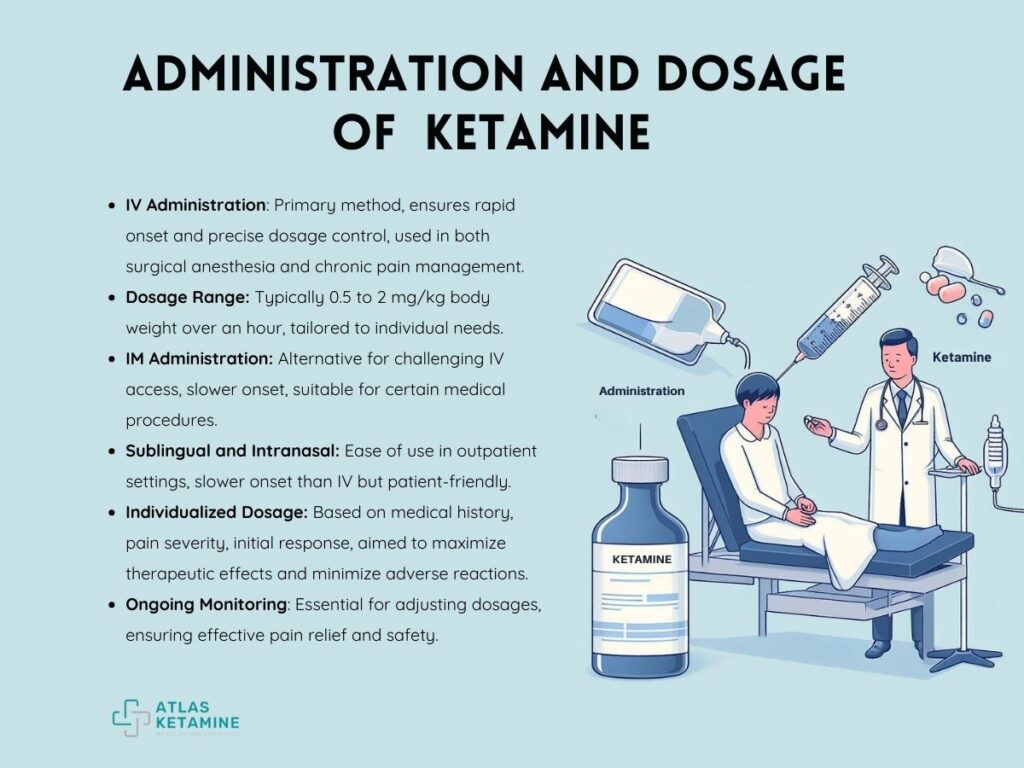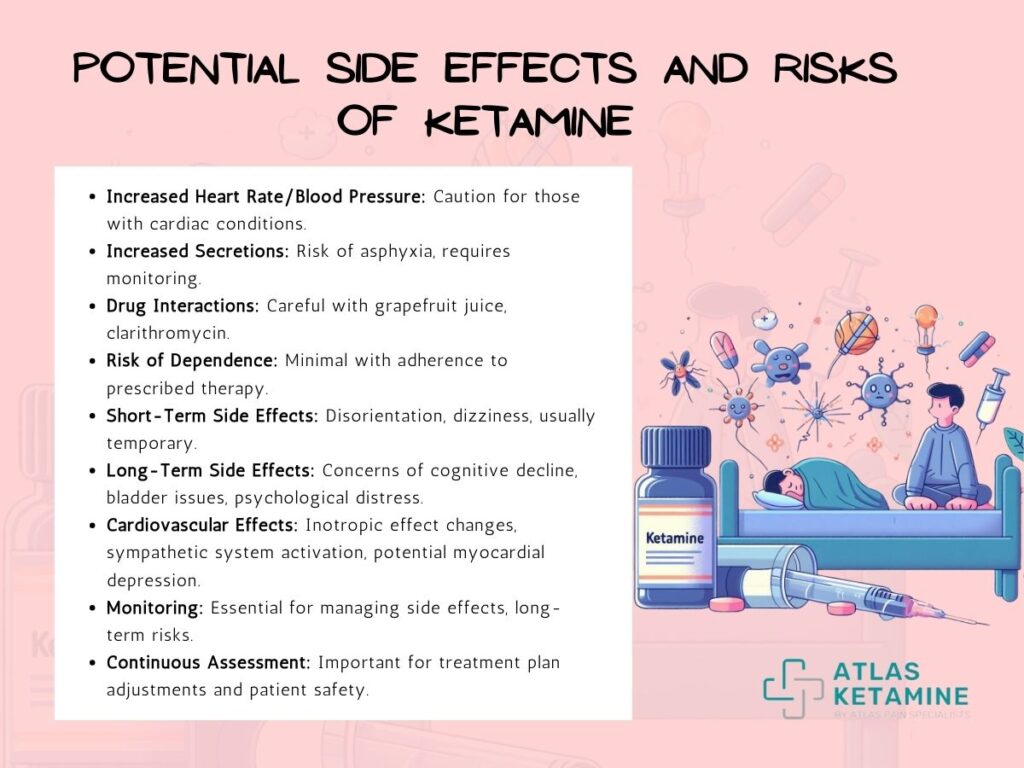Ketamine was first created as an anesthetic, but it has now expanded beyond its conventional uses to become a complex drug with important effects on pain control. Unlike other anesthetics, it acts as a dissociative anesthetic, causing a trance-like state while still having analgesic effects.
Ketamine's distinct pharmacological properties, particularly its modulation of the N-methyl-D-aspartate (NMDA) receptors, have propelled it into the spotlight as a promising intervention for pain relief. Recent years have witnessed a resurgence of interest in Ketamine, particularly in pain management.
Beyond its traditional use in surgical settings, Ketamine has emerged as a viable option for chronic pain conditions, challenging conventional norms in pain management. So, how ketamine for pain can work for you?
How Does Ketamine Work?
The historical trajectory of Ketamine spans over five decades, initially gaining recognition for its anesthetic properties in the 1960s as a safer alternative to phencyclidine. Since then, its applications have expanded, encompassing diverse fields such as psychiatry, emergency medicine, and chronic pain management.
Unlike traditional opioids, Ketamine's mechanism of action involves blocking NMDA receptors, resulting in dissociation between sensory input and conscious perception. This property not only contributes to its anesthetic function but also makes it a promising candidate for pain management.
It exists in various forms, and its medical applications include anesthesia and pain management, while its recreational use has led to concerns about misuse and addiction. Ketamine has FDA approval for specific medicinal uses, demonstrating its therapeutic potential despite the drug's tendencies for abuse.
These include intravenous infusions for the therapy of acute pain and nasal spray formulations for depression that are resistant to treatment. The FDA's approval acknowledges ketamine's medicinal potential and encourages more study into the drug's numerous medical applications.
Ketamine's Role in Pain Management
The successful treatment for neuropathic pain, or neural mechanical pain, involves inhibiting the NMDAR, an excitatory glutamatergic receptor located in the spinal and supraspinal areas that are involved in the afferent transmission of nociceptive signals. In chronic pain situations, prolonged nociceptive stimulation increases and activates NMDAR at dorsal horn synapses, amplifying and improving the brain's processing of pain signals (central sensitization).

Chronic Pain Conditions
The complex and damaging nature of chronic pain has led to research into ketamine as one possible treatment. One of ketamine's main characteristics, NMDA receptor regulation, makes it a strong contender for treating chronic pain disorders.
1. Neuropathic Pain
Neuropathic pain, arising from nerve damage or dysfunction, often proves challenging to treat. Ketamine's ability to modulate NMDA receptors interrupts the pain signals associated with neuropathy, offering relief where traditional medications may fall short.
2. Fibromyalgia
Ketamine also exhibits potential in the treatment of fibromyalgia, a condition marked by diffuse musculoskeletal pain and fatigue. Its complex mode of action tackles both the feeling of pain and the amplification of pain signals that fibromyalgia patients frequently experience.
3. Complex Regional Pain Syndrome (CRPS)
Ketamine studies have focused on CRPS, a disorder characterized by extreme localized pain, edema, and skin color changes. Also referred to as reflex sympathetic disease (RSD), CRPS usually affects a single limb. It produces a "pins and needles" feeling in addition to burning or squeezing aches.
Acute Pain Situations
Ketamine is essential for managing acute pain in addition to chronic pain, especially in surgical and trauma-related settings.
1. Surgical Settings
In surgical contexts, Ketamine's use as an anesthetic agent has expanded to include its postoperative analgesic benefits. Its unique mechanism not only induces anesthesia but also provides ongoing pain relief post-surgery, reducing the need for additional analgesics.
2. Trauma-Related Pain
For trauma patients experiencing acute pain, Ketamine emerges as a valuable tool. Its rapid onset of action and ability to maintain hemodynamic stability make it a preferred option in emergency situations, ensuring effective pain control without compromising patient safety.
Understanding Ketamine's role in pain management necessitates an exploration of its mechanisms of pain relief, which extend beyond traditional analgesics. The subsequent section will delve into these mechanisms, shedding light on how Ketamine operates at the molecular level to alleviate both chronic and acute pain.
Administration and Dosage
Ketamine is typically administered via an intravenous (IV) line in clinics that treat chronic pain. Typically, a small dosage is started during treatment, and doctors may gradually raise it.
When used to treat chronic pain, ketamine infusion dosages typically range from 0.5 to 2 milligrams per kilogram of body weight over an hour. Your location and what your care team believes will be best for your symptoms will determine the options that are available to you.

Intravenous (IV) Ketamine
The intravenous route stands as the primary mode of Ketamine administration in medical settings, ensuring rapid onset and precise control over dosage. IV infusions are commonly employed in both surgical anesthesia and chronic pain management.
The controlled delivery allows healthcare providers to tailor the dosage to individual patient needs, balancing the analgesic effects with potential dissociative side effects. This method's versatility extends from acute pain situations in emergency rooms to the more prolonged pain management protocols for chronic conditions.
Intramuscular (IM) Ketamine
Intramuscular administration offers an alternative for situations where IV access may be challenging or when a slower onset of action is acceptable. While not as commonly used as IV administration, IM Ketamine maintains its efficacy, making it suitable for certain medical procedures and emergency settings.
The slower absorption can be advantageous in mitigating dissociative effects, particularly in patients prone to adverse psychological responses.
Sublingual and Intranasal Administration
Recent advancements have explored alternative routes of administration, including sublingual and intranasal delivery methods. These routes offer potential benefits in terms of ease of use and patient comfort, particularly in outpatient settings.
While nasal sprays are used for intranasal administration, sublingual administration entails applying a Ketamine solution under the tongue. While these techniques might not be as quick to start working as IV therapy, they do offer more alternatives for customized, patient-centered pain management strategies.
Individualized Dosage Considerations
Determining the appropriate dosage of Ketamine involves a nuanced evaluation of factors such as the patient's medical history, pain severity, and response to initial administrations. For the therapeutic effects to be maximized and adverse effects like dissociation and hallucinations to be reduced to a minimum, the dosage must be carefully adjusted.
Healthcare providers must engage in comprehensive assessments and ongoing monitoring to adjust dosages as needed, ensuring optimal pain relief without compromising patient safety.
Potential Side Effects and Risks
Ketamine therapy seems to be safe and well-tolerated at lower doses. However, there are a few negative effects of ketamine to be mindful of, such as:
- Increased heart rate
- Increased blood pressure
- Increased secretions that may cause asphyxia
Before exploring ketamine therapy, discuss any underlying cardiac conditions with your healthcare provider. You may be more affected by these side effects than others. Higher doses or more frequent administration of ketamine often carry a higher risk of side effects.

Several prescription and over-the-counter drugs may interact with ketamine. In particular, certain patients may be more susceptible to negative side effects from ketamine if they consume grapefruit juice or take the medicine clarithromycin.
A modest dose of ketamine may appear like a huge dose because these chemicals activate particular bodily processes. Although the risk of developing physical and psychological dependence on ketamine is minimal if you adhere to your doctor's recommended course of therapy, it is still possible.
Short-Term Side Effects
Although each person's experience with ketamine therapy is unique, many patients report feeling more at ease and having less discomfort throughout the infusion. Mild side effects, including disorientation or dizziness, are possible in some people, although they usually go away a few hours after the infusion.
Even though these side effects are usually temporary and go away as the medication is metabolized, their existence emphasizes the value of attentive monitoring and prompt medical supervision.
Long-Term Side Effects
Ketamine use for an extended period of time raises concerns about possible adverse effects, including cognitive decline, bladder problems, and psychological anguish. This is especially true when managing chronic pain. Concerns regarding the effects on the urinary system and cognitive function may arise from high-dose, continuous exposure.
Ketamine affects the cardiovascular system in two ways: directly, by decreasing inotropic effects, and indirectly, by stimulating them. The sympathetic nervous system is activated during stimulation, which is linked to norepinephrine release from sympathetic ganglia, inhibition of the vagal nerve, inhibition of norepinephrine re-uptake at peripheral nerves and non-neuronal tissues like the myocardium, and systemic release of catecholamines.
Myocardial depression can occur following a high-dose ketamine infusion or when administering ketamine repeatedly over the course of minutes to hours. After a low dose of ketamine infusion, tachycardia, systemic and pulmonary hypertension, increases in cardiac output, and myocardial oxygen consumption are all signs of cardiovascular stimulation.
As a result, healthcare professionals need to carefully consider the advantages over any long-term hazards, placing a strong emphasis on continuing assessment and treatment plan modification.
Integrative Approaches
Integrative pain treatment solutions combine traditional therapy approaches with Ketamine in order to maximize overall effectiveness. Combining conventional treatments with the unique processes of ketamine, this approach aims to manage pain from multiple angles.
A comprehensive treatment plan for chronic pain issues involves the use of Ketamine with pharmaceuticals, physical therapy, and lifestyle adjustments. This integrative methodology minimizes the possibility of side effects associated with higher dosages of any one modality while optimizing pain alleviation for healthcare providers.
The integration of psychological support and therapy is integral to a holistic approach when utilizing Ketamine for pain management. Addressing psychological issues related to chronic pain, such as anxiety and depression, can be greatly aided by mental health specialists.
Because ketamine addresses both the physical and emotional aspects of pain, combining it with therapies such as cognitive-behavioral therapy (CBT) can increase its effectiveness. For people living with chronic pain, this cooperative approach cultivates a more resilient foundation.
Holistic methods include dietary changes, mindfulness exercises, and adjunctive therapy to enhance the effects of ketamine. In addition to improving general well-being, stress reduction, exercise, and nutrition may also have an indirect impact on how painful something feels.
A complete approach to pain management that goes beyond pharmaceutical interventions is promoted by incorporating these components into the treatment plan, which recognizes the interdependence of mental and physical health.
How Ketamine Can Work For Your Back Pain
Ketamine and chronic pain are still being studied, and much research has to be done. A newer method of treating chronic pain is ketamine therapy, though you should speak with your care team if you'd want to give it a try.
It's important to remember that ketamine therapy is a continuous treatment for chronic pain, and it can take several infusions to provide long-term pain relief. The patient's response to the treatment and the degree of their discomfort will determine how many and how often infusions are required.
All things considered, ketamine therapy is a potentially effective treatment for chronic pain, providing a non-addictive and somewhat safe substitute for prescription painkillers. Find out more about the potential benefits of ketamine for treating back pain.
